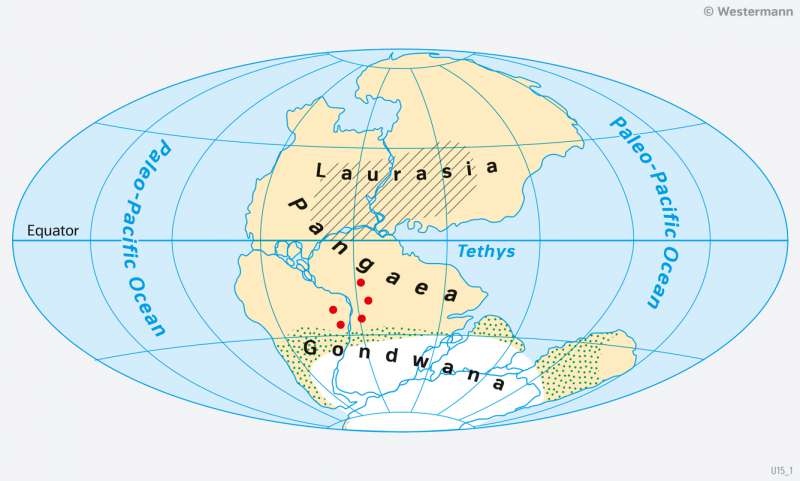The World - The continental drift since the Mesozoic Era
The History of the Earth
978-3-14-100890-6 | Page 12 | Ill. 1

Overview
The distribution of the continents has changed constantly in the past epochs of Earth's history. This is because the outer crust of the Earth, consisting of oceanic and continental crust, is only a comparatively thin skin of rock that "floats" on the Earth's mantle, consisting of several plates. These plates are constantly shifted by tectonic processes. Continental drift has shifted entire masses of earth, formed new mountain ranges, closed old oceans and opened new ones.
Paleo-continents and paleo-oceans
At the beginning of the Mesozoic Era 250 million years ago, there was a primeval continent (Pangaea) and a primeval Pacific Ocean. Pangaea gave rise to two continents, Laurasia and Gondwana, until the Lower Cretaceous (142 - 98.9 million), which were separated by the Tethys Ocean, but also increasingly disintegrated. Laurasia included North America with Greenland and the largest part of Eurasia. Gondwana consisted of South America and Africa, while India and a land mass of Antarctica and Australia had already split off.
60 million years ago, shortly after the end of the dinosaur age, the primordial Tethys Ocean was almost closed, and India had shifted further towards Asia. The Atlantic Ocean had formed between South America and Africa, and in the Southern Hemisphere the separation of Australia from Antarctica was becoming apparent. North America and Eurasia, on the other hand, were still connected by the Greenland land bridge.
In the course of the Paleogene, the Tethys Ocean closed, creating the Mediterranean Sea, the Alps and a land bridge between Africa and Eurasia. North and South America were connected by the new mountain ranges in Central America. The collision of the Indian Shield with Asia led, among other things, to the formation of the Himalayas. Australia (with New Zealand and New Guinea) began its development, isolated over millions of years, with an independent animal and plant world. The European North Sea opened up between Greenland and Norway.
Theory of continental drift
The founder of the theory of continental drift was the German geophysicist and meteorologist Alfred Wegener, who published his work "The Origin of Continents and Oceans" in 1915. Wegener had concluded from the similarity of the coastlines of South America and Africa that these land masses were fragments of a prehistoric continent. He supported his thesis with a number of clues. Identical fossil plants and animals were found on both sides of the Atlantic, including ferns from the Glossopteris flora of the Palaeozoic era and remains of the Mesosaurus, a freshwater reptile from the Permian era that could not possibly have swum across the Atlantic. As further evidence, Wegener listed matching glacial drag marks from the Ice Age at the border of the Carboniferous and Permian periods, similar rock sequences and other geological parallels. Based on such evidence, Wegener believed in the existence of a former supercontinent, which he called Pangaea. Wegener's theory was sharply opposed and ridiculed by many scientists of his era but created a basis for today's model of plate tectonics.




